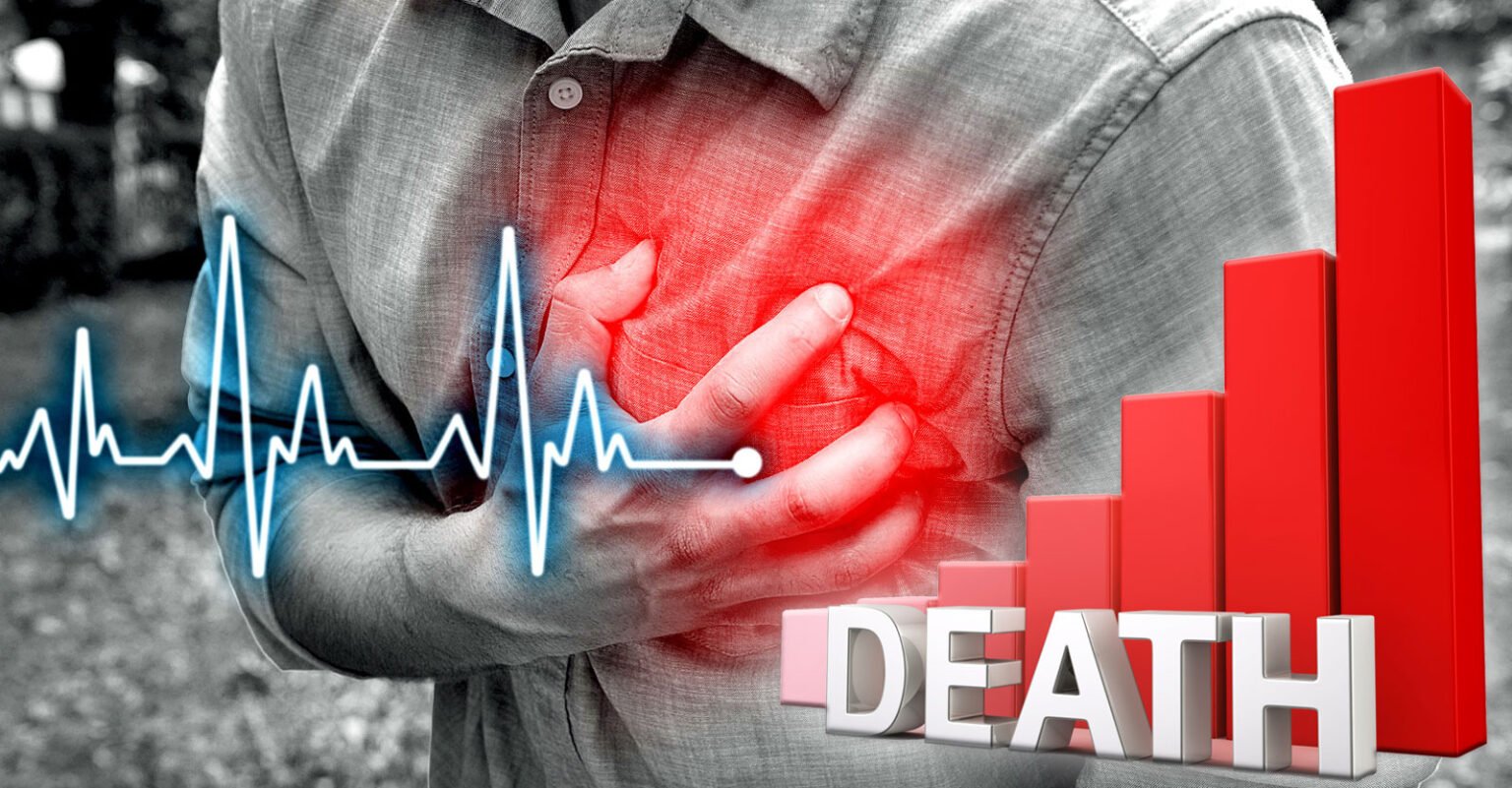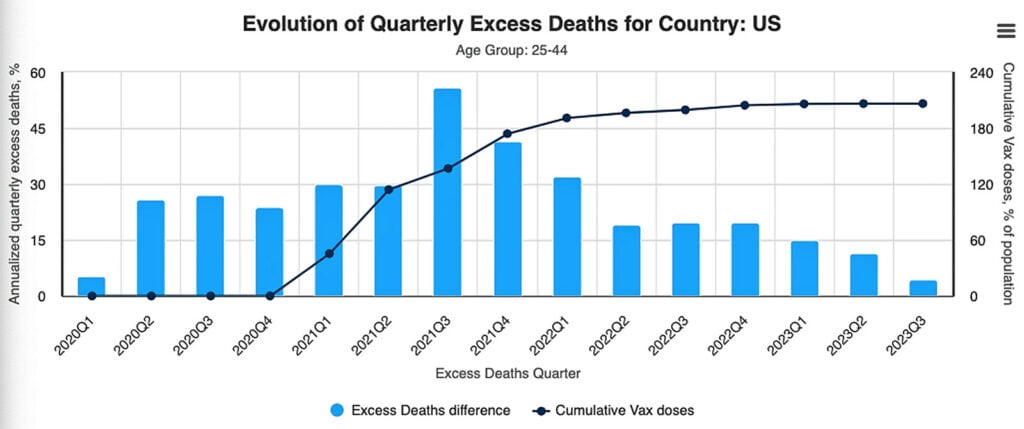CDC-Linked Study Blames Increase in Deaths Related to Cardiovascular Disease on Stress, COVID — But Doesn’t Mention mRNA Vaccines
Guest Post by
The authors of a research article published in the American Journal of Preventive Medicine blamed the pandemic-era rise in the U.S. cardiovascular disease death rate on disruptions in access to healthcare, stress and the lingering effects of COVID-19, but the widely promoted article did not discuss existing scientific evidence linking the vaccines to heart issues.

Researchers from the Centers for Disease Control and Prevention (CDC) and Northwestern University Feinberg School of Medicine blamed the pandemic-era rise in the U.S. cardiovascular disease death rate on disruptions in access to healthcare, stress and the lingering effects of COVID-19 in a research article published in the American Journal of Preventive Medicine.
The article’s authors confirmed that the “significant uptick in the cardiovascular disease death rate that began in 2020 has continued” and that the trend “reverses improvements achieved in the decade before the COVID-19 pandemic.”
They suggested several possible explanations for the reversal of the decades-long progress in driving down cardiovascular deaths — including emerging evidence that COVID-19 infections can directly damage the heart and blood vessels and studies indicating COVID-19 survivors face increased cardiovascular risks for up to a year.
Patient hesitancy and reduced access to routine healthcare early in the pandemic may have also delayed critical prevention and treatment, they said.
The researchers did not explore the role of mRNA vaccines in their analysis of recent trends in cardiovascular disease. However, they noted that death rates remained high in 2022 despite hospitalizations declining and COVID-19 vaccines being widely available.
CDC epidemiologist and article lead author Rebecca C. Woodruff, Ph.D., MPH, told the journal’s publisher, Elsevier, that the pandemic crisis disrupted aspects of daily life, making it harder for people to follow through with behaviors that prevent heart disease, such as “managing blood pressure, eating well, being physically active, quitting tobacco, getting healthy sleep, managing weight, controlling cholesterol, and managing blood sugar,” according to a press release.
Elsevier — which also publishes The Lancet, ScienceDirect, Scopus and other scientific journals and databases — on Jan. 24 issued the press release promoting the article, which was originally published in November 2023.
The press release led to coverage of the research article by media outlets such as the New York Post and Medical Xpress.
A review of headlines from the past several weeks containing alternative explanations for increased heart attacks links the increase to snow shoveling, climate change, new COVID-19 variants, stress and junk food, alarm clocks, structural racism, the holidays, drugs and alcohol, blunt chest injuries and underlying heart conditions for young athletes, leisure time exercise, winter chill, hot weather, early meals, regular marijuana use, death of a sibling, Viagra, COVID-19 and flu and long COVID.
Authors’ reasoning ‘disingenuous at best’
Dr. Michelle Perro, CEO of GMOScience told The Defender the precipitous rise in cardiac, neurologic demise and turbo cancers occurred after the introduction of the mRNA jabs, not at the beginning of the COVID-19 pandemic.
“The exponential rise in pediatric myocarditis certainly cannot be attributed to a lack of management of blood pressure or blood sugar,” said Perro, who also co-authored “What’s Making our Children Sick? How Industrial Food Is Causing an Epidemic of Chronic Illness, and What Parents (and Doctors) Can Do About It.”
Perro said the authors’ attempt to draw attention away from the “true culprits” was “disingenuous at best.”
Scientific journals are filled with studies and case histories of vaccine-induced myocarditis and pericarditis, especially in younger people.
Perro pointed to a paper published Jan. 24 in Cureus by Dr. Peter McCullough, Jessica Rose, Ph.D., Stephanie Seneff, Ph.D., a senior research scientist at Massachusetts Institute of Technology, and others that she said “sets the record straight” on vaccine-induced heart disease.
The researchers reanalyzed Pfizer’s trial data and found that the COVID-19 vaccine did not undergo adequate safety testing and demonstrated an unacceptably high harm-to-reward ratio. Harms cited include cardiomyopathy, cardiac arrest, chronic systemic inflammation and immune system dysfunction.
A similar study reviewing the deaths occurring in Pfizer’s COVID-19 vaccine trials, published in October 2023 in the International Journal of Vaccine Theory, Practice, and Research, determined there was a more than 3.7-fold increase in cardiac events in trial subjects who received the Pfizer vaccine versus the placebo.
Of the 15 subjects who died suddenly or were found dead, 14 died of a heart-related condition. Of these, 10 were vaccinated.
Pfizer failed to report this data to regulators, according to the authors of the forensic analysis.
The authors of the Cureus paper stated, “We urge governments to endorse a global moratorium on the modified mRNA products until all relevant questions pertaining to causality, residual DNA, and aberrant protein production are answered.”
A peer-reviewed research article published Jan. 27 in Sage Journals, authored by McCullough, Rose and Nicolas Hulscher of the University of Michigan School of Public Health, found that COVID-19 vaccination is strongly associated with a “serious adverse safety signal of myocarditis,” particularly in children and young adults, resulting in hospitalization and death.
In a tweet Sunday, Rose added the following disclaimer to the article:
“Disclaimer: Ignore the ‘plain language summary’ — especially the conclusion, please. I did not write it and I do not agree with it. Obviously. Apparently, this is the price we sometimes pay now to get stuff published. It’s shameful. At least the work is out there now.”
In the study, “Autopsy findings in cases of fatal COVID-19 vaccine-induced myocarditis” published Jan. 14 in ESC Heart Failure, the authors, including McCullough, reviewed 28 autopsies of those who received the mRNA jab and found 26 showed “the cardiovascular system was the only organ system affected.”
The average age of death was 44 years old, and most died within a week of the last vaccination.
An independent review of each case determined the deaths were most likely causally linked to the vaccines. The temporal relationship and consistency with known vaccine myocarditis characteristics suggested a high probability that COVID-19 vaccines can cause fatal myocarditis, according to the study.
The study left open the question of how many of such deaths are actually attributed to the vaccine on death certificates.
A 2022 German study reviewed by McCullough found that of 35 fatalities occurring within 20 days of vaccination, 10 were ruled out as not due to the injection, while the remaining 25 had final diagnoses “consistent with a vaccine injury syndrome,” McCullough wrote, including “myocardial infarction, worsening heart failure, vascular aneurysm, pulmonary embolism, fatal stroke and vaccine-induced thrombotic thrombocytopenia.”
McCullough told The Defender:
“With more than 3,400 peer-reviewed manuscripts reporting record injuries, disabilities, and cardiac death after COVID-19 vaccination, I am greatly concerned that these all-cause cardiovascular mortality data reflect the impact of mass, indiscriminate, mandated vaccination.”
Dr. Pierre Kory, president and chief medical officer of the Frontline COVID-19 Critical Care Alliance, in November elaborated on the heart damage caused by the mRNA vaccines:
“Spike-induced damage occurs by numerous mechanisms, including necrosis of vessel walls leading to things like aortic dissection [and] … myocarditis. … Fibrinoid aggregates circulating in the blood caus[e] poor perfusion in the microcirculation as well as hypercoagulability in the blood causing strokes and heart attacks.”
Kory appeared on the Jimmy Dore Show last week to discuss the pandemic-era mortality trends for younger people:
Kory told Dore:
“The government should be funding a massive study — not only epidemiologically but pathophysiologically — into exactly what they’re dying from, how and can it be prevented. …
“The reason why nothing’s being done is because to do something you have to identify the problem, you have to talk about the problem and you have admit that the vaccines are the cause. And you can see that around the world, there’s no appetite for doing that.”
A closer look at the American Journal of Preventive Medicine research article
For the study, the researchers analyzed almost 11 million death certificates from 2010-2022 of U.S. adults ages 35 and older. From 2010-2019, cardiovascular disease mortality rates declined steadily. But in 2020, the mortality rates started increasing. They increased further in 2021 and remained high in 2022.
An estimated 228,524 excess cardiovascular disease deaths occurred from 2020-2022 — around 9% higher than expected based on earlier trends. The increases, primarily driven by heart disease but also stroke, were seen across multiple age, gender and racial/ethnic groups.
The 35-54 age group saw the greatest increase in cardiovascular disease mortality rate — 13.5% — with mortality in ages 75-84 increasing by 10.3%, in Asian or Pacific Islander adults by 12.2% and in Black adults by 10.6%.
These findings indicate a reversal of the trend from 2010-2019, which had an age-adjusted cardiovascular disease mortality rate decline of 8.9%. The most recent year showing rates as high as those in 2022 was 2011, at 336.8 deaths per 100,000 people, according to the article.
All-cause mortality, insurance industry data show similar trends
The impact of cardiovascular disease mortality in younger people noted in the research article is reflected in the all-cause mortality data and insurance industry trends shared by Edward Dowd, the former Blackrock portfolio manager who authored “‘Cause Unknown’: The Epidemic of Sudden Deaths in 2021 & 2022.”
Dowd’s data sets are divided into age groups 25-44 and 45-64, with both showing the greatest rise in excess mortality starting in 2021 when compared with other age groups, coincident with the rollout of the COVID-19 vaccines.
Excess deaths for the 25-44 age group nearly doubled starting mid-2021, from about 30% in the first two quarters of that year, to nearly 56% in the third quarter, 42.5% in the fourth quarter and 32% in the first quarter of 2022. After that, excess deaths declined somewhat but remained above average for this age group through the data set ending in the third quarter of 2023.

An insurance industry whistleblower reported to Dowd a 40% excess mortality rate for the 25-64 age group during 2021. Insurance companies reported double the payouts for death benefits in 2021 compared to historical norms.
However, the Society of Actuaries in their May 2023 report denied a connection to COVID-19 vaccines.
The following graph shows an insurance industry chart — note the spike beginning in the third quarter of 2021.

This article has been archived for your research. The original version from The Burning Platform can be found here.




